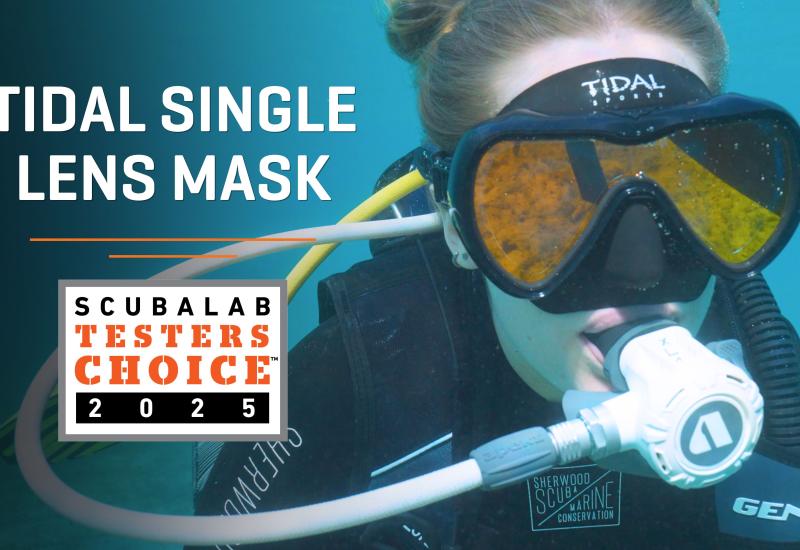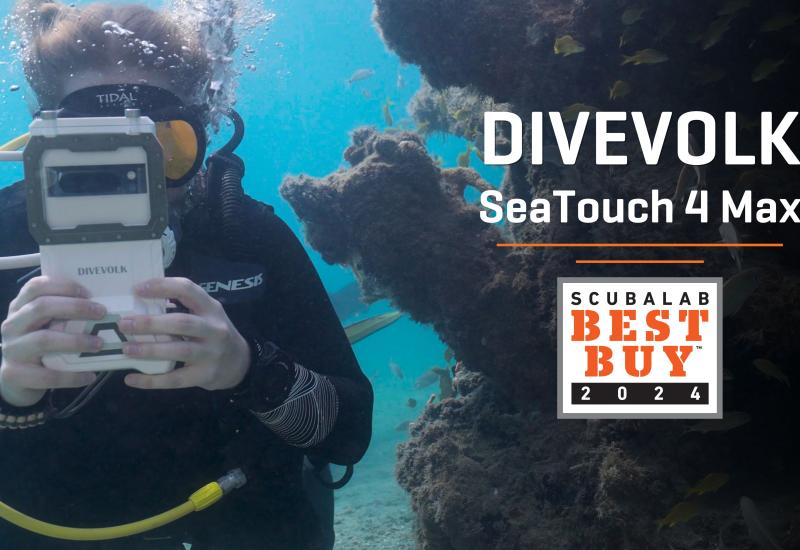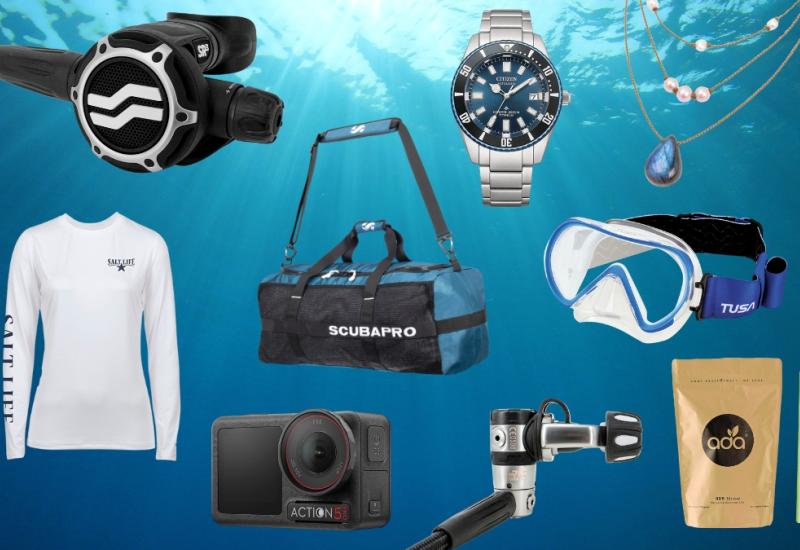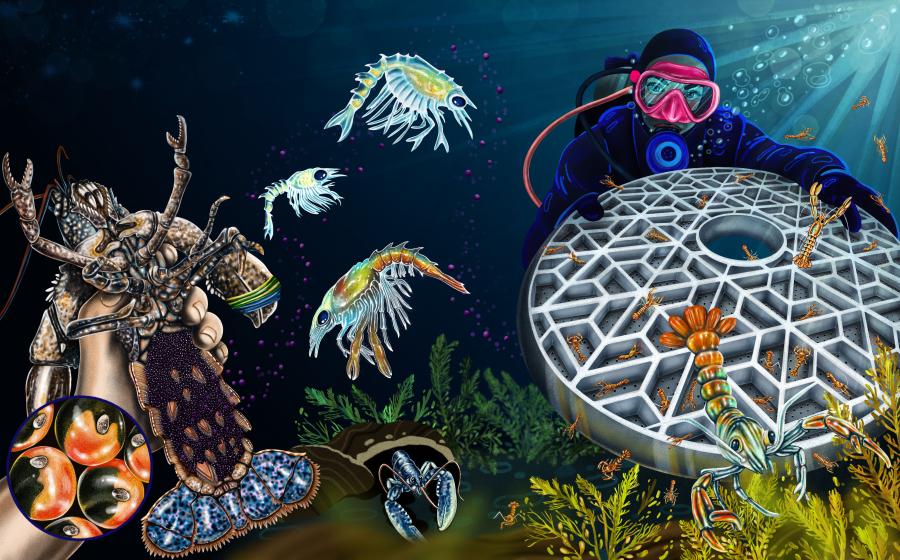The Best Scuba Regulators of 2022 Reviewed
Head-To-Head Testing
How We Test
Jump to results | Download complete test results here
Objective testing was conducted on an ANSTI wet breathing simulator that measures effort (“work of breathing”) required to move air through a reg as it is subjected to a series of depths and breathing rates. The testing was done at Dive Lab, a commercial testing facility in Panama City Beach, Florida.
Tests are performed at an HP supply pressure of 750 psi (+/- 25 psi). Regs are tested in the face-forward position, and those with breathing adjustments are set at the wide-open/no-free-flow point.
The simulator pressurizes the chamber to simulate depths of 132 feet of seawater, 165 fsw and 198 fsw. Each “breath” of the machine moves a specified amount of air, called the tidal volume, through the reg. We do this at 2 liters/20 breaths per minute, 2.5 L/25 bpm and 3 L/25 bpm. Multiplying the tidal volume by the breathing rate gives you the Respiratory Minute Volume (RMV).
Why do we test at these depths and breathing volumes?
40 RMV at 132 fsw: This represents 20 breaths per minute times a 2-liter volume. This is pretty much the maximum recreational depth at a somewhat aggressive breathing rate.
62.5 RMV at 165 fsw: This rate represents the European conformance standard EN250. This is also the depth and breathing rate commonly used by manufacturers when determining a reg’s performance. This is the U.S. Navy’s Class A test depth and breathing rate.
75 RMV at 132 fsw or deeper: This simulates the potential demand at maximum recreational depth for a diver at an extremely heavy work rate.
The breathing simulator monitors how much effort is required to “breathe” in and out, measuring the work of breathing in joules per liter (j/L). As depth and breathing rate increase (and with it, the density of the air being moved), the work gets harder. Many modern regs are able to perform at 40 RMV at 132 fsw with less than 1 j/L of work.
If a reg doesn’t exceed the test parameters in our standard tests— the toughest of which a human diver would be hard-pressed to keep up for more than a couple of minutes—we push it to more extreme conditions. Regs aren’t tested for a pass/ fail grade but to objectively gauge their performance in carefully controlled conditions. You can see how each reg performed on the simulator in the charts that accompany each review.
Ergonomic testing was conducted at Alexander Springs in central Florida by a team of divers who evaluated each reg in the following categories, assigning a score from 5 (excellent) to 1 (poor), and recording observations and comments about performance.
- Ease of breathing: How well does the reg deliver air when you are propelling yourself forward in a standard swimming position? Face-up position? Head-down position?
- Wetness: During normal swimming, how dry does the reg breathe? Face-up position? Head-down position?
- Bubble interference: How well does the reg deflect bubbles from your field of view?
- Ease of clearing: How difficult is it to clear the reg by exhalation or using the purge?
- Purge stiffness: Is it soft and progressive or forceful and abrupt?
- Resistance to free-flow: Is the Venturi control easy to use and effective at blocking free-flows?
- Breathing Adjustment: Is the adjustment easy to find and use? Is it effective?
- Comfort of second stage: Overall comfort, taking into account its size, shape and weight.
- Noise: Does the reg operate with excessive noise?
Ask Robby
Q: Why did you change the breathing rates for the simulator test?
A: The Respiratory Minute Volumes (RMVs) used for this year’s test have been updated slightly. Previously, ScubaLab tested regulators using a consistent tidal volume of 2.5 liters while changing the number of breaths per minute. This year, thanks to modern equipment we were able to adjust both the number of breaths per minute and the tidal volume in order to more closely match real-world performance. This allowed us to conduct testing at respiratory rates that are nearly identical to previous testing, along with some additional rates for better representation of overall performance.
NEX - MONTEREY

NexPrice $1,022.99 (as tested)
Contact nexdive.com

Nex1st stage.
This reg’s modular first stage is offered in two color options and three styles that provide divers with four, five or nine LP ports. We tested the nine-port model, which includes a swiveling LP turret, outfitted with an optional environmental seal paired with balanced diver-adjustable second stage. The reg took excellent and very good scores on the simulator at recreational depth and beyond. In the water, testers scored it excellent for ease of breathing in normal and head-down position. It took a perfect score for dryness. “So smooth, quiet and comfortable,” one tester said. The teeny-tiny second stage is lightweight with a small profile. It took the top score for comfort, bubble interference and noise. The Venturi can moderate free-flow, but even with the breathing adjustment tight it can’t quite manage to stop it entirely. The reg scored excellent for ease of clearing, with divers praising the responsive purge that only requires a light touch. This “sweet little reg,” as one diver described it, was a favorite of testers, offering strong performance, comfort and flexibility. The Monterey is our Testers Choice.

PADI StaffNex Monterey Breathing Simulator Results
DIVE RITE — XT4/XT1

Dive RitePrice $539
Contact diverite.com

Dive Rite1st stage.
Significantly smaller than its XT2 predecessor, Dive Rite’s latest second stage has been paired with the XT1 first stage for a lightweight breather with serious performance. “Smooth as butter,” is how one tester described this reg’s air delivery, which scored excellent for ease of breathing in swim and head-down positions, and very good in face-up. It took the top score for dryness face-up. “Bone dry in all positions,” one tester said. On the simulator it performed very good when delivering air at light-to-heavy breathing rates; although breathing effort increased when pushed past 40 RMV, it still provided a good work of breathing. The reg scored very good for purge stiffness and ease of clearing. Small exhausts on the cover and angled exhaust tees keep bubble interface to a minimum. “Hardly see any bubbles, even face-forward,” one tester noted. Divers appreciated the large, ergonomic breathing adjustment. Even with the Venturi set to dive, the reg was reluctant to free-flow. With excellent and very good scores all around, the XT4 was a favorite of testers.

PADI StaffDive Rite Breathing Simulator Results
HIGHLAND — VORTEX

HighlandPrice $599.95
Contact xsscuba.com

Highland1st stage.
On the simulator, this reg took excellent scores for work of breathing across our breathing rates at recreational depths and beyond—it even provided good work of breathing scores at 200 feet. Testers noticed the same smooth, easy air delivery in the water. They scored the reg excellent for ease of breathing in normal and head-down position, and very good in face-up. “Breathes almost without effort,” one tester said. It scored good for dryness in swim and head-down position, and very good face-up. Designed with a bit of restraint, the purge requires a bit more effort to engage, and scored just good for purge stiffness. “Really have to push it in before you get anything,” one diver observed. The large breathing resistance knob scored excellent. It is ergonomic and effective, with a very wide range of adjustment. The Venturi switch was effective at taming and preventing free-flow. The second stage scored very good for comfort and noise, and good for bubble interference. The first stage regulator features two HP ports and a rotating turret with five LP ports.

PADI StaffHighland Vortex Breathing Simulator Results
SCUBAPRO — MK25 EVO/G260 CARBON BT

ScubaProPrice $1,379
Contact scubapro.com

ScubaPro1st stage.
This update to Scubapro’s G260 technical regulator system features a scratch-resistant Black Tech coating on both the first and second stage. It took perfect scores on the breathing machine, delivering consistently low work of breathing across all of our tests regardless of depth and breathing rate. Even when pushed to 300 feet, work of breathing was only 1.19 j/L. In the water, testers scored it excellent for both dryness and ease of breathing in normal/swim position, and very good for both in face-up and head-down positions. “Super easy breather and whisper quiet” and “zero-effort breathing” were typical of tester comments. “Dry in all positions,” one diver noted. Scoring very good for comfort, the second stage uses a durable carbon-fiber cover to reduce weight. The smooth metal breathing adjustment knob has a noticeable effect on inhalation effort, and the predive/dive switch easily tames free-flows at the surface. With great all-around performance, this reg was among the favorites of several divers. “Nice reg in every way,” is how one tester described it.

PADI StaffScubaPro MK24 Evo G260 Carbon Breathing Simulator Results
SCUBAPRO — MK11/S270

Monica MedinaPrice $559
Contact scubapro.com
This reg’s second stage scored very good for comfort. Made of fiberglass-reinforced nylon with a special scratch-resistant coating, it inspired many tester comments such as “lightweight and comfortable” and “pretty lightweight.” It scored good for bubble interference. The balanced diaphragm MK11 first stage is equally small, and offers two HP and four LP ports in convenient T-shaped configurations. Testers scored it excellent for ease of breathing and dryness in swim position. “Like it anticipates my next breath,” is how one tester described it. The reg scored very good for ease of breathing head-down, and good face-up. A few testers noted that the reg breathes a little wet outside of normal/swim position. The reg scored just good for noise, with a few testers reporting a quiet but distracting “rasping noise” during inhalation. On the simulator, it took excellent scores across the board, and proved capable when pushed beyond 200 feet. The reg scored very good for resistance to free-flow, and is easy to clear thanks to its powerful, easy-to-reach purge.

PADI StaffScubaPro MK11 s270 Breathing Simulator Results
SEAC — P-SYNCHRO

SeacPrice $299
Contact seacsub.com

Seac1st stage.
Scoring very good for ease of breathing in all orientations, this reg impressed with its smooth, easy air delivery. “Solid, steady breather,” one tester noted. Some wetness was detected, but overall, it scored very good for dryness in normal and face-up positions. On the simulator, it delivered excellent and very good scores at 40 RMV or less. Performance suffered slightly when subjected to extreme breathing rates, but it still provided good work of breathing. The second stage feels big, but isn’t heavy. It scored good for comfort. The inline exhaust tees open primarily to the sides, releasing bubbles out of view of the diver. “Excellent bubble deflection,” one tester said. The Venturi control is tiny, but effective at taming free-flow at the surface. Described as “easy to access and activate” by one diver, the responsive purge tied the top score in the test. The placement of the first stage ports orients hoses like the spokes of a wheel, which can be less than ideal. Overall, the P-Synchro is a budget- and beginner-friendly reg with solid, reliable performance.

PADI StaffSeac P Synchro Breathing Simulator Results
XS SCUBA — INSPIRE

XS ScubaPrice $479.95
Contact xsscuba.com

XS Scuba1st stage.
This reg gave an excellent performance on the simulator, and consistently had some of the lowest work of breathing scores in the test. In the water, testers described air delivery as “super smooth” and “no abrupt on/off breathing, feels natural.” The reg scored excellent for ease of breathing in normal and head-down. It scored very good for ease of breathing face-up, and very good for dryness in all positions. Testers described it as “super quiet” and “very relaxing and pleasing to dive.” The knurled breathing adjustment is ergonomic and provides a ton of range. The Venturi operates smoothly and tames free-flows with ease. Divers found the purge required a bit more effort than they would have liked, and scored it just good for stiffness. The feature-rich second stage is large but lightweight and well-balanced. It earned a very good score for comfort. The balanced diaphragm first stage has two HP ports and a rotating turret with four LP ports. A favorite among testers, the Inspire provides great performance and comfort at a below-average price. It is our Best Buy for regs.

PADI StaffXS Scuba Inspire Breathing Simulator Results











